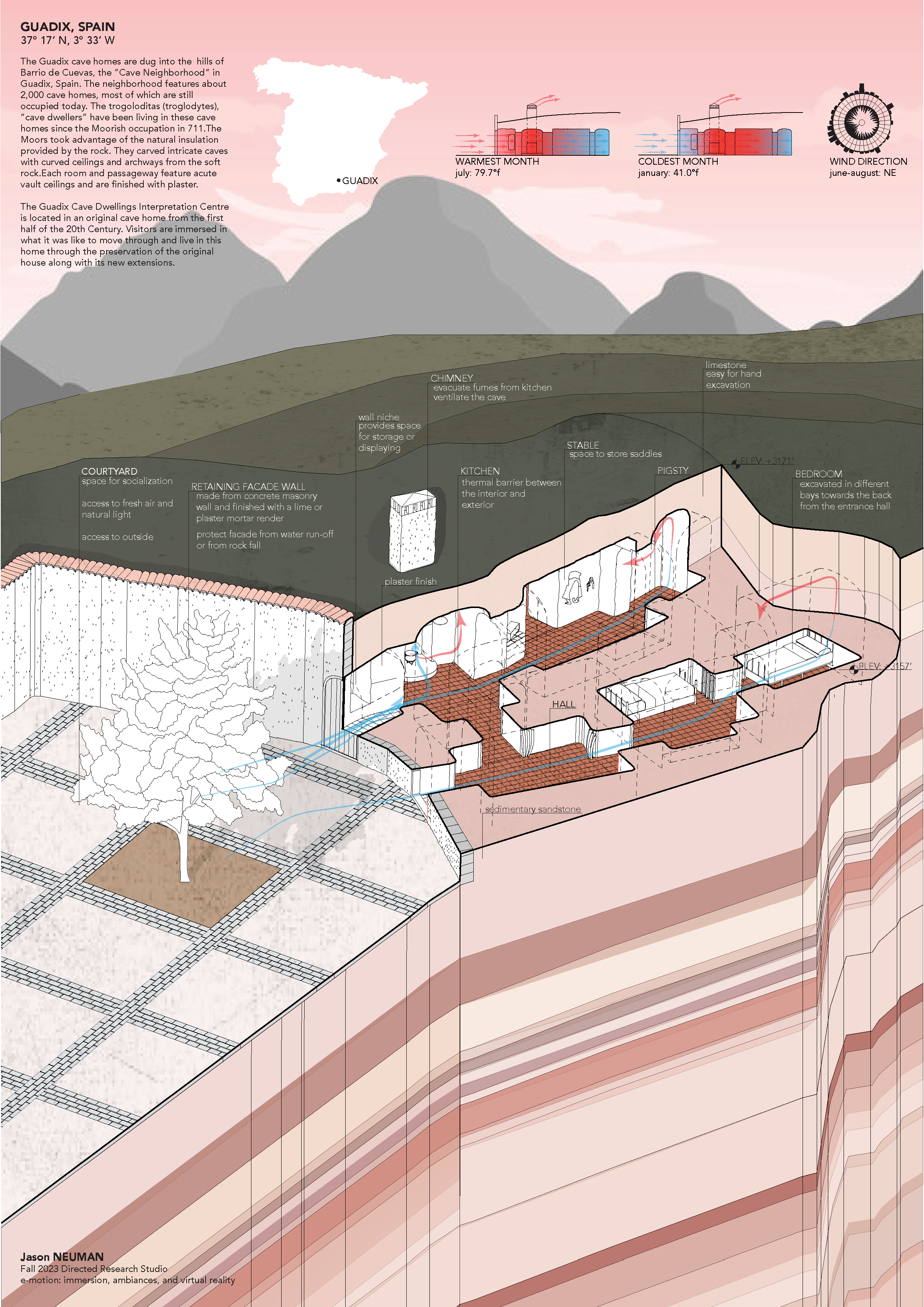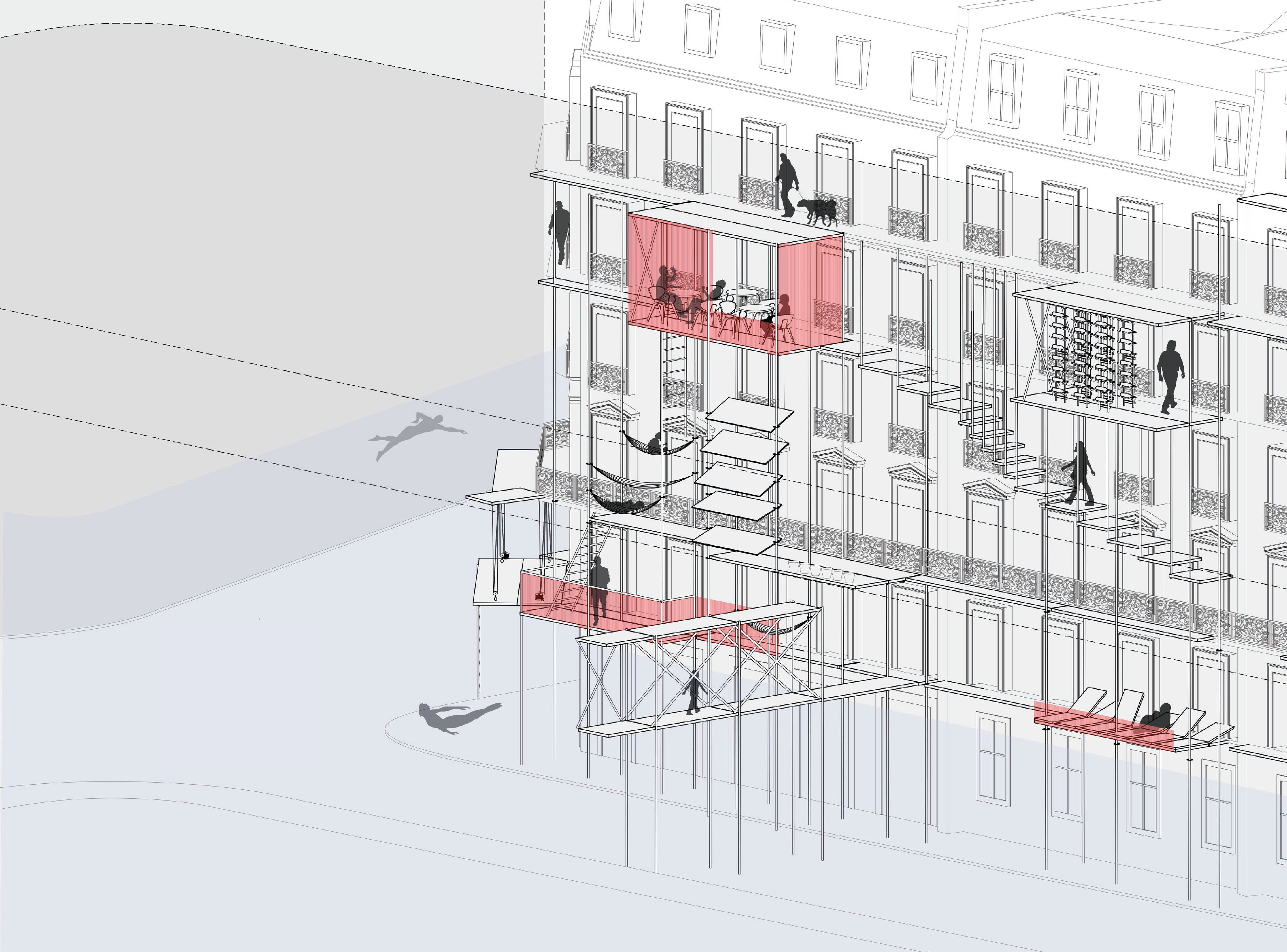(Water) Immersion, Ambiances, VR
Directed Research StudioThe Pennsylvania State University, USA
Fall 2024
Following excerpts from Abbas, Yasmine. “Immersion at Mineral Speed.” 5th International Congress on Ambiances: Sensory Explorations, Ambiances in a Changing World, October 8-10, 2024:
In this Directed Research Studio, students have created immersive experiences by focusing on the geometrical, material and sensory parameters of underground ambiances. Over the course of a semester, they have explored, using a hybrid physical and digital mode of inquiry, how space can s(t)imulate a sense of presence, a sense of being ‘in’ the Earth. To imagine a world, they have dreamed of an architecture experienced in movements, a movement that is mental, a matter of translation and acculturation, by virtually travelling to other places, a movement that is physical/tangible, through (im)material manipulation and model making, and a movement that is digital, using 360º camera and VR technologies to walk within and through a space. Immersion, in its complete sense and operation, must enable the tree kinds of movements.
In this Directed Research Studio, students have created immersive experiences by focusing on the geometrical, material and sensory parameters of underground ambiances. Over the course of a semester, they have explored, using a hybrid physical and digital mode of inquiry, how space can s(t)imulate a sense of presence, a sense of being ‘in’ the Earth. To imagine a world, they have dreamed of an architecture experienced in movements, a movement that is mental, a matter of translation and acculturation, by virtually travelling to other places, a movement that is physical/tangible, through (im)material manipulation and model making, and a movement that is digital, using 360º camera and VR technologies to walk within and through a space. Immersion, in its complete sense and operation, must enable the tree kinds of movements.
(Earth) Immersion, Ambiances, VR
Directed Research StudioThe Pennsylvania State University, USA
Fall 2023
Following excerpts from Abbas, Yasmine. “Immersion at Mineral Speed.” 5th International Congress on Ambiances: Sensory Explorations, Ambiances in a Changing World, October 8-10, 2024:
Immersion is an emotional, and utopian operation as it can afford both the escape from a broken world and, at the same time, the experience of an imaginary, real-virtual, world. Immersion, from the Latin “immers” and “immergere,” meaning dipping into, designates the action of entering a liquid or atmosphere (in a climatic sense and, by extension, as it relates to building ambiances). Immersion also describes the absorption (incorporation) into a particular activity, culture, or space, the merging with another body or melting within something. It is inherently sonorous, sensorial, and haptic.
Immersion is an emotional, and utopian operation as it can afford both the escape from a broken world and, at the same time, the experience of an imaginary, real-virtual, world. Immersion, from the Latin “immers” and “immergere,” meaning dipping into, designates the action of entering a liquid or atmosphere (in a climatic sense and, by extension, as it relates to building ambiances). Immersion also describes the absorption (incorporation) into a particular activity, culture, or space, the merging with another body or melting within something. It is inherently sonorous, sensorial, and haptic.
Starting their interior voyage from the examination of excavated dwellings, hideouts, or spaces of extraction, students devise the concept for an ambiance that considers the “(im)material”, the phenomenal property of materials (Mori, 2002), volcanic rock, granite, or salt. Physical models, the “void model”, the “atmospheric model” and their digital counterparts, the “360º atmospheric model” and the “VR environment” are means for them to explore a material phenomenon; to immerse and navigate within the projected ambiances that was guided by the material phenomenon studied; to assess how mentally absorbing the spaces can be; and to narrate the concept, sometimes exaggerating the effects – storytelling being another use for VR by architectural practices (Schipper & Holmes, 2021).

e-motion: Immersion, Ambiances, VR
Directed Research StudioThe Pennsylvania State University, USA
Spring 2023
 Edward Kaufman. Above: Sun Color Diagram that explains the concept of the underground space. Spring 2023. Students create an atmospheric model in which they place a 360º camera.
Edward Kaufman. Above: Sun Color Diagram that explains the concept of the underground space. Spring 2023. Students create an atmospheric model in which they place a 360º camera. Right: Edward’s model in which a 360º camera is placed to produce 360º movie to be experienced with a VR headset. A first step toward a high-tech immersive experience. Photo © Yasmine ABBAS


Edward Kaufman. Render of the sunken courtyard using the visual of the virtual space developped with Rhino and Unity and emphasizing the drama of space colored by light. Diagram and render © Edward KAUFMAN.
50 CC of Paris Air
Directed Research StudioThe Pennsylvania State University, USA
Fall 2021 and 2022
Marcel Duchamp’s 1919 work of art, a small glass ampoule purchased from a Parisian pharmacist that contained fifty cubic centimeter of Paris air, inspires the idea of the Directed Research Studio – Paris: How can architects decode, encapsulate, and re-encode into a sound architectural proposition a Parisian atmosphere or ambiance?
Students researched Parisian ambiances along the city’s waterways – the Seine river that gave birth to the city, the canals, and the covered Bièvre river – through a variety of mediums, maps, oral presentations, texts, news articles and films. They made architectural commentaries on the city of Paris through the making of speculative projects that resonated with the ambiance studied. The architectural mediums and artefacts employed enhance the overall narrative of the ambiance and concept that had prompted the architectural proposition.

Xi Jin. Collage City: Paris Détournement based on an interpretation of the Situationist map. IMAGE © Xi JIN
As a highly sought after country for asylum, refugee applications in France have doubled over the past 20 years. The chronic shortage of housing for the refugees disrupts the ability for Paris to serve as a place of refuge, and often generates a counter-reaction to the reception of those in need. Illegal migrant camps have persistantly appeared throughout Paris and are inhumane, unsafe, and unsanitary, often, provoking authorities to forcibly dismantle illegal campsites.
In choosing a site for an intervention, trends with makeshift camps show a tendency for refugees to temporarily settle amongst parks, waterways, bridges, and transit stations. The 19th arrondissement contains the Canal Saint-Martin, Parc de La Villette, offices for asylum applications, and neighbors major rail stations. Many refugees find themselves in this area, and the the majority of removed migrant camps are found in and around the Villette neighborhood.
![]()
In choosing a site for an intervention, trends with makeshift camps show a tendency for refugees to temporarily settle amongst parks, waterways, bridges, and transit stations. The 19th arrondissement contains the Canal Saint-Martin, Parc de La Villette, offices for asylum applications, and neighbors major rail stations. Many refugees find themselves in this area, and the the majority of removed migrant camps are found in and around the Villette neighborhood.


La Folie du Monde: Parisian Refugee Housing
IMAGES + TEXT © A. DAMUS
The deconstructivisit language of the park [de la Villette]’s folies perversely contrast with the constructivist need of the refugee folie as a generative expansion of living space.
FLOOD ESCAPE as described by Audrey Leung, DRS, 50CC of Paris Air, Fall 2022:
As the streets of Paris emptied, occupants of the city fled while water poured in. A once bustling city life returned to the serene state of the flowing river. The iconic rooftops and buildings are still recognizable, Paris remains true to its core even in this state. From the water emerges striations. Once empty skeletal framing mounted on the facades of each building are now populated. The life of the streets reemerges into the air, with bridges forming across these islands. Mechanical systems to cafes and laundry all find their new places across the vertical. Chatter now populates what is now remembered as only a brief moment of silence for the city.
As the streets of Paris emptied, occupants of the city fled while water poured in. A once bustling city life returned to the serene state of the flowing river. The iconic rooftops and buildings are still recognizable, Paris remains true to its core even in this state. From the water emerges striations. Once empty skeletal framing mounted on the facades of each building are now populated. The life of the streets reemerges into the air, with bridges forming across these islands. Mechanical systems to cafes and laundry all find their new places across the vertical. Chatter now populates what is now remembered as only a brief moment of silence for the city.

Audrey Leung. Above: Cartography of the flood level in Paris. Below: Axon of the Flood Escape project. Drawings © Audrey LEUNG.
